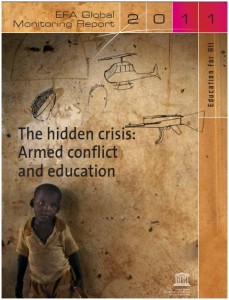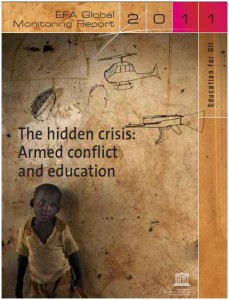By YVONNE T. CHUA
 PARTLY owing to the armed conflict in Mindanao, the Philippines counts among the countries that are not on track to achieve education for all (EFA) by 2015, according to Unesco’s latest monitoring report.
PARTLY owing to the armed conflict in Mindanao, the Philippines counts among the countries that are not on track to achieve education for all (EFA) by 2015, according to Unesco’s latest monitoring report.
“Countries affected by armed conflict are among the farthest from reaching the Education for All goals,” according to the 2011 EFA Global Monitoring Report launched Tuesday in Paris and New York by the United Nations Educational, Scientific and Cultural Organization.
The Philippines, with a longrunning Muslim insurgency in the south, was among the 35 countries affected by armed conflict from 1999 to 2008 and singled out by this year’s report titled The hidden crisis: Armed conflict and education.
Adopted in 2000 in Dakar, Senegal, the six EFA goals are expanded early childhood care and education, free and compulsory primary education for all, learning and life skills for young people and adults, increase in adult literacy by 50 percent, gender parity by 2005 and gender equality by 2015, and improved quality of education.
But Unesco Director General Irina Bokova said in the foreword of the report, “Warfare is…destroying opportunities for education on a scale that is insufficiently recognized. The facts are telling. Over 40 percent of out-of-school children live in conflict-affected countries.”
Unesco estimated that armed conflict has robbed 28 million children of schooling and increased inequalities in education.
“In the Philippines, the non-attendance rate in ARMM (the Autonomous Region in Muslim Mindanao) is more than four times the national average,” according to report.
It added that the share of young people in the ARMM with less than two years of education is also more than four times the national average.
Statistics cited by the report also showed that the share of 7- to 16-year-olds without education is 12 percent in the ARMM, a far cry from the 2 percent national average.
When fighting broke out between government troops and the Moro Islamic Liberation Front in August 2008, government and other agencies were at one point serving about 700,000 evacuees in 567 evacuation centers in Mindanao whose lives, including their education, had been disrupted. The Geneva-based Internal Displacement Monitoring Center that year said it was the world’s largest displacement and the Philippines had the most neglected displacement situation.
In scores of evacuation centers, including in Datu Piang, Maguindanao, refugees waited for more than a year before they could return home or be relocated. Others remained refugees.
As a consequence of being deprived of an education, the functional literacy rate in the Muslim Mindanao region is lowest in the country. Only 71.6 percent of 10- to 64-year-olds can read, write and count, reported the 2008 Functional Literacy, Education and Mass Media Survey (FLEMMS) conducted by the National Statistics Office.
This is in sharp contrast to the national figure where nine out of 10 Filipinos are functionally literate.
Also worrisome when it comes to functional literacy is Eastern Visayas, one of the country’s poorest regions and one of the areas where government is fighting Asia’s longest running communist insurgency. The rate there is 72.9 percent.
Functional literacy is defined as the percentage of 10- to 64-year-olds “who have higher level of literacy which includes not only reading and writing skills but also numerical skills.”
The Unesco study, however, reported “promising signs of progress” in conflict areas like the Philippines where the MILF in 2009 entered into an action plan with the United Nations to release minors.
In February, the government and the Muslim and communist rebels resumed the long-stalled peace talks.
Because of the conflict in the south, the Philippines has been a main beneficiary of official development assistance. It received an average $1.1 billion for the period 2007-08, making it the ninth biggest recipient of ODA after Iraq, Afghanistan, Ethiopia, Sudan, Palestinian, Uganda, Congo, the Unesco report showed.
Education, however, has not received the same level of funding support from the Philippine government and has been classified by Unesco among the countries that have “continued to neglect education financing.”
The UN agency said the share of the gross national product allocated to education has risen with national income in many countries. But not in the Philippines.
“Other countries have converted a smaller share of the growth premium into education financing. In the Philippines, real spending on education increased by 0.2 percent annually from 1999 to 2008 while the economy grew by 5 percent a year. As a result, the already low share of national income invested in education by the Philippines has fallen over time, to just 2.4 percent in 2007,” it said.
The report reminded countries that national commitment to education, shown in terms of GNP or percentage growth in education spending, is a partial measure of EFA financing capacity.
It warned that low levels of education spending holds back efforts to achieve universal primary education and other EFA goals.
This appears true in the case of the Philippines which the Unesco said is among the countries close to achieving universal primary primation but “have been unable to take the final step, largely because of a failure to reach highly marginalized populations.”
Universal primary education means “children everywhere, boys and girls alike, will be able to complete a full course of primary schooling.”
Getting children into school one thing; keeping them there and making sure they complete basic education is another.
The Philippines, Ethiopia and Malawi have high concentrations of pupils dropping out in Grade 1, according to Unesco.
The number of school dropouts in the Philippines stood at 961,000 in 2008, and is projected to stay constant, even increase to 1.007 million by 2015, instead of decreasing.
The EFA report said dropout levels in countries like the Philippines often rise sharply as enrolment surges, increasing class sizes and placing pressure on resources. It also noted large classes of predominantly first-generation learners, many of them far older than the official school entry age.
The link between poverty and a child’s chance of completing grade school is clear, according to Unesco.
Data from its 2011 report indicate that only slightly more a tenth of Manobos who are 17 to 22 years old have completed primary school compared to 90 percent of Tagalogs. More children in urban areas than those in the rural areas finished primary education.
The National Statistical Coordination Board, which tracks the country’s performance in meeting the Millennium Development Goals (MDGs), has itself rated the country’s chances of achieving universal primary education as “low.”
NSCB data show that as of 2008, net enrolment ratio in primary education stood at only 85.1. The Department of Education defines net enrolment ratio, also called participation rate, as the ratio of enrolment of children in the school age range to the total population of that age range.
According to the NSCB, only three in four who start Grade 1 reach Grade 6. Those who finish Grade 6 within the required number of years of study make up 73.3 percent. And literacy rate of 15- to 24-year-olds stands at 96.6 percent. The country should be logging 100 percent for all these rates by 2015.
The lack of education is closely linked to the risk of childhood death, Unesco said.
Deaths among children below 5 in the Philippines are three times higher among those of mothers with no education than among those of mothers with some high school education, according to statistics.
“Women’s empowerment through education saves lives. The more educated women are, the more likely they are to have better access to reproductive health information, family planning and antenatal care, and to delay childbirth, have fewer children and provide better nutrition to their children, all of which reduce the risk of child mortality,” the EFA monitoring report said.
Formal education has also been identified by a 2007 Labor Force Survey in the Philippines as being the single most important factor contributing to individual wage differentials, it said.
The 2011 report showed more males than females entering primary education in the Philippines. But by the time they enter high school, more women than men complete their schooling.
This year’s report has been endorsed by Nobel Peace Prize laureates Oscar Arias Sánchez of Costa Rica, Shirin Ebadi of Iran, José Ramos-Horta of Timor-Leste and Archbishop Desmond Tutu of South Africa.
